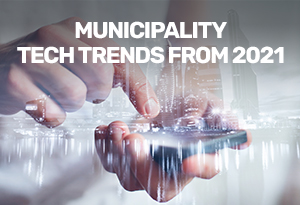One of the most rewarding yet most challenging things when working in technology is sorting out “The Hype” versus “The Reality.” To elaborate as we near the end of 2021 and move into 2022 there will be a flurry of analyst reports about the latest technology trends in various industries. These are called things like “Top 10 technology trends…” Before we rush to read what’s going to change the world we live and work in 2022, let’s have some fun reviewing what’s happened in 2021.
The "They Got it Right List."
According to Tech Trends for Smart Cities in 2021:
- Hybrid workforces, more cloud applications, digital tools, and mobile connectivity continues to grow.
- Government regulations will accelerate the digital transformation of Smart Cities and municipalities.
- A large percentage (well over 50%) of cities will push high speed connectivity as a public utility.
- Multiyear plans will be established for MUNIs to turn to digital environments.
- $200B+ to be spent within 3 years on Smart City/municipalities with focus on utilities, telecom, and consultants.
The first bullet point can be cut and pasted every year for the foreseeable future so that’s simply the “safe pick.” The more interesting trend in 2021 has been governments like the United States have announced funding programs and regulations to ensure municipalities and Smart Cities leverage and evolve with technology. For instance, in Pennsylvania the state is giving citizens water credits for rainwater which requires the necessary technology for reporting and sharing the data. The other prediction which has become true is simply the increase in the amount of money being invested in new technologies for the upcoming few years.
So how will municipalities really leverage these trends and secure these funds? The reality is, a large percentage of MUNIs struggle to turn legacy processes (pen, paper + data entry) into a digital strategy and transformative technology deployment. This isn’t because they aren’t intelligent. It’s because there is so much information (and misinformation) and options to sort through to even begin framing a strategy.
What's Next?
So how can MUNIs leverage the next round of trends, align with government regulations and be strategic? The answer is really a combination of:
1. Keep learning, evaluating, and determining what trends are “real” within your MUNI organization. Knowing industry trends won’t turn you into a place of innovation overnight but can provide you with insights to think strategically.
2. Evaluate new digital technology trends where they can effectively impact your business. Back office systems used by office staff aren’t the same technologies that are required for field operations personnel…nor used by customers, etc. Understand who the technology is impacting and who is using it, and then help plan alignment across these groups.
3. Be strategic, but also tactical so you deliver results. Said another way, it’s important to be strategic when digitizing your business especially in areas like municipalities. Strategic direction is your north star and yearly industry trends will help. At the same time be tactical with short term planned deliverables as they will help create the foundation needed to get down the strategic road you wish.
Looking forward to seeing what analysts say about MUNIs in 2022, and good luck!

